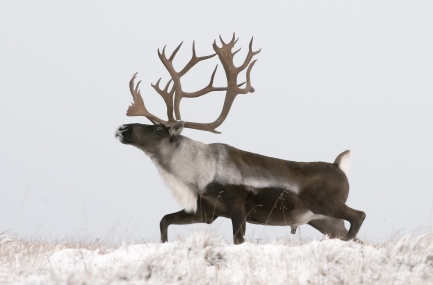Smithsonian Traveling Exhibition Examines the Importance of the Boreal Forest
The boreal forest is Earth’s largest terrestrial ecosystem and the last intact forest in the world. In North America, it covers much of Alaska and Canada and extend into the contiguous U.S. It stores two-to-three times the amount of carbon as tropical forests and helps regulate Earth’s climate. These are just a few facts visitors will learn at the new Smithsonian traveling exhibition “Knowing Nature: Stories of the Boreal Forest / Historias del bosque boreal.” Developed by the Smithsonian Institution Traveling Exhibition Service (SITES), it will begin its national tour April 19 at Michigan State University Museum in East Lansing, Michigan. It will be on view at the Smithsonian Affiliate through Nov. 12.
The bilingual (English/Spanish) exhibition integrates the themes of climate change, Indigenous perspectives and the relationship between people and nature, offering stories of resilience, strength and hope in a changing world. It will take the public on a journey to discover the beauty of the boreal forest using a combination of sensory experience, researched-based science, curiosity-building activities and first-person narratives.
“We have prioritized the telling of this story through many voices,” said Carol Bossert, project manager for science at SITES. “The result is an exhibition that invites visitors to reflect upon their own ways of knowing nature and what it means for us to build a sustainable future together.”
“Knowing Nature” includes commissioned objects from Indigenous artisans, world-class nature photography and interactives that encourage multi-generational exploration. Visitors will be able to see, hear and feel the forest from listening to the birds and animals that call the boreal home to touching moss that carpets the forest. The exhibition also includes a video featuring interviews with members of Indigenous Sovereign nations, conservationists and climate scientists.
Visitors will see a three-foot birchbark canoe model that illustrates the traditional canoe-building methods used by the Constance Lake First Nation. A pair of handmade snowshoes in the Cree pointed-toe style exemplifies the traditional techniques that community Elders are passing along to the next generation. A pair of earrings made from birchbark and moose hide shows how contemporary wearable art pieces are created with traditional style and materials from the boreal forest. The commissioned objects also include a canvas bag painted using natural dyes and decorations seen on caribou hunting coats, a nearly lost traditional technique used by Innu women who painted symbolic landscape on hunting coats to attract the caribou spirit and assure a successful hunt.
“Knowing Nature: Stories of the Boreal Forest / Historias del bosque boreal” was made possible by the National Audubon Society with additional support from The Anders Foundation, Charlie and Nancy Hogan, and Anne C. Madison.
The Smithsonian Institution Traveling Exhibition Service (SITES) and Smithsonian Affiliations are critical national outreach units at the Smithsonian Institution. For more than 70 years, SITES has been connecting Americans to their shared cultural heritage through a wide range of exhibitions about art, science and history. Smithsonian Affiliations establishes and maintains the Smithsonian’s long-term partnerships with museums, educational organizations and cultural institutions in the U.S., Puerto Rico and Panama. Together, SITES and Affiliations share the Smithsonian's vast resources with millions of people outside Washington, D.C. Visit sites.si.edu and affiliations.si.edu for more information.
The National Audubon Society protects birds and the places they need, today and tomorrow. Audubon works throughout the Americas using science, advocacy, education and on-the-ground conservation. State programs, nature centers, chapters and partners give Audubon an unparalleled wingspan that reaches millions of people each year to inform, inspire and unite diverse communities in conservation action. A nonprofit conservation organization since 1905, Audubon believes in a world in which people and wildlife thrive. Learn more at audubon.org.
As Michigan’s first Smithsonian Affiliate, the Michigan State University Museum is an innovative and experimental collaboratory that exists to catalyze creativity. A space where people can openly explore, express and experiment with ideas across disciplines and interests, and indulge their natural curiosity about the world. The museum features three floors of special collections and changing exhibitions. The museum is located on 409 West Circle Dr. next to Beaumont Tower on the university’s campus. Visitor parking is available at metered spaces at the Grand River Ramp, one block away at the corner of Grand River Avenue and Charles Street. For more information, call (517) 355-2370 or visit museum.msu.edu.
# # #
SI-111-2023









